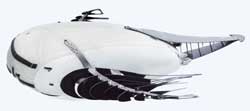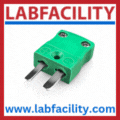
Posted to News on 22nd Nov 2007, 10:11
Fluidic muscles give Aqua_ray grace and speed
Festo's fluidic muscle devices have been used by Evologics to develop a remote controlled, robotic version of the manta ray.

Festo has been working in conjunction with the Berlin-based bionics research company Evologics to develop a remote-controlled fish, whose form and kinematics are modelled on the movement patterns of the manta ray. Known as Aqua_ray, the fish uses an innovative water-hydraulic drive unit coupled with Festo fluidic muscles to produce smoothly-flowing muscular movements, which are transformed into the dynamic flapping of a wing to propel it through the water. Created primarily to demonstrate the design flexibility of fluid power, the artificial manta ray provides a highly manoeuvrable remote sensing platform, with potential applications in marine research and for inspecting undersea pipelines and cables.
Analysing the movement through water has established that rays are excellent in both submarine 'flight' and gliding. The up-and-down motion of their pectoral fin in water closely resembles the flapping of a bird's wings in the air. This wavelike movement combines maximum propulsion with minimum energy consumption, and the streamlined form lends graceful movement to the manta ray, in particular, and makes it a veritable submarine acrobat.
 The Aqua_ray uses Festo fluidic muscles as actuators. These consist of hollow elastomer tubes with integrated woven aramide fibres. When the muscle is filled with fluid (usually air or water), its diameter increases and it contracts longitudinally, giving rise to smoothly flowing elastic movement. In conjunction with Evologics' patented Fin Ray Effect, the fluidic muscles constitute Aqua_ray's central propulsion and control unit. The Fin Ray Effect is derived from the functional anatomy of a fish's fin and almost perfectly imitates the mode of propulsion executed by the natural model. It is entirely due to the mechanics of the bony rods that constitute the fin's supporting structure that the wing can be arched to ensure even distribution of forces; this makes for a highly efficient drive mechanism.
The Aqua_ray uses Festo fluidic muscles as actuators. These consist of hollow elastomer tubes with integrated woven aramide fibres. When the muscle is filled with fluid (usually air or water), its diameter increases and it contracts longitudinally, giving rise to smoothly flowing elastic movement. In conjunction with Evologics' patented Fin Ray Effect, the fluidic muscles constitute Aqua_ray's central propulsion and control unit. The Fin Ray Effect is derived from the functional anatomy of a fish's fin and almost perfectly imitates the mode of propulsion executed by the natural model. It is entirely due to the mechanics of the bony rods that constitute the fin's supporting structure that the wing can be arched to ensure even distribution of forces; this makes for a highly efficient drive mechanism.
Like a heart, Aqua_ray's water-driven central vane cell pump generates the propulsion energy. This is conveyed via specially developed valves to three opposing pairs of fluidic muscles. Their contraction force is transferred by high-strength artificial tendons to the wings and the tail, which, in turn, transform the tendon travel of 55mm into a vertical wing amplitude of more than 550mm.
Through the use of new elastic materials for all moving components and the 3D-deformable skin, and by matching the elasticity and self-adaptive characteristics of the internal wing and tail structures to the hydrodynamic forces, it has been possible to reproduce the kinematics of nature's marine model.
The change in direction of force effected by the tendons makes it possible to relocate the dorsal and thoracic muscles to the side, providing more room for energy storage and transformation components along with the control and sensory units. The requirements regarding technology and performance efficiency - such as payload - could thus be reconciled with the biological advantages of aquatic movement.
Aqua_ray is highly manoeuvrable and can be operated either as a hydrostatic glider or with actively flapping wings. This makes for considerable energy savings. Thanks to its form and its mode of propulsion, Aqua_ray is suitable for application in diverse fields of marine research without disturbance to the natural environment. Its smooth contours and lack of rotating parts such as propellers make it particularly suitable for use in environmentally sensitive areas.
Technical data
- Overall length: 61.5cm
- Overall width: 96.0cm
- Height: 14.5cm
- Approximate weight: 10kg
Materials
- Torso: fibreglass-reinforced plastic
- Wings and tail: CURV, water-jet carved
- Skin: polyamide with elastan content
- Drive/control units: two servo drive units for orientation of the wings and a brushless motor powers a pump that drives the Festo fluidic muscles
- Approximate maximum speed: 1.8km/h
- Minimum flight duration under full load: 30 minutes
- Sensors/diagnostics: five angular sensors, two force sensors and one potentiometer
- Control: wireless digitally addressable two-way communication
- Computing power: two units with 10MIPS at 40MHz





